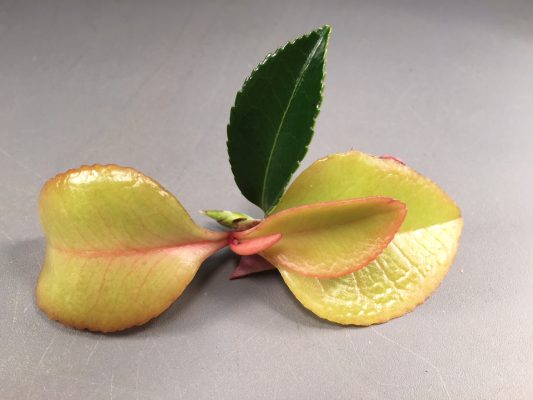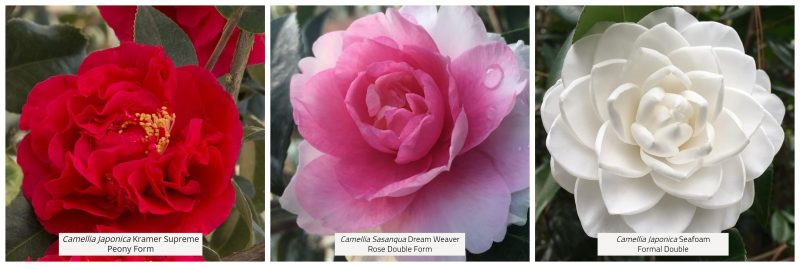.
Camellia
Camellias are one of our favorite evergreens. Deep green foliage, vibrant flowers in fall or winter, minimal care. What’s not to love? Additionally, they are one of the few blooming plants that prefer some shade. Best part? Camellias are deer-resistant!
Two varieties of Camellias are frequently found in the garden: Camellia Japonica and Camellia Sasanqua. The main difference between them is their bloom time. Sasanquas bloom from late fall to early winter whereas Japonicas bloom from late winter to early spring. Japonicas also bear slightly larger leaves and flowers than Sasanquas. Nevertheless, both varieties are equally beautiful and come in several sizes, colors, and flower forms. A recent addition to the Camellia family is Camellia x Williamsii, a hybrid form of the Japonica. x Williamsii tend to bloom a little earlier than Japonicas.
On average, Camellias can reach 10-15′ tall and 5-7′ wide at maturity. However, Camellias are slow growers and they can easily maintained at a smaller size with regular pruning. Newer varieties of Camellias are being bred to stay smaller. These varieties usually average 4-6′ tall at maturity.
Care
Generally speaking, Camellias are pretty much maintenance-free. That being said, there are a few things to keep in mind in order to provide the best growing environment for them.
When it comes to light, Camellias prefer part shade. They thrive in locations with morning sun and afternoon shade. Dappled shade is an equally good amount of light. Camellias can tolerate full shade, however, they will not bloom as profusely. In contrast, Camellias don’t enjoy full or afternoon sun. If exposed to too much sun, they can suffer from leaf scorch as well as require extra watering.
Equally important is the soil in which you plant your Camellia. They do best in well-draining soil. Amend clay soils with Coast of Maine Lobster Compost to improve drainage. Once established, they are moderately drought tolerant. That being said, Camellias do appreciate the occasional watering during dry periods. Avoid areas that are prone to flooding or stay wet.
Due to their slow growth, Camellias can be grown in containers for several years. Use a well-draining potting soil like Coast of Maine Potting Soil. Refresh the soil after a few years or amend with Lobster Compost.
Another key point is pruning. Prune Japonicas and x Williamsii immediately after they have finished blooming in early spring. Prune Sasanquas in late winter or early spring. You can prune dead or damaged branches at any time. Because of their slow growth, you most likely won’t have to prune every year unless you are keeping your Camellia small.
Finally, fertilize Camellias in spring when new leaves begin to develop. Fertilize a second time with a reduced rate in late summer/early fall. Use an acidic fertilizer like HollyTone.
Camellia Flower Forms
Camellias have six different bloom forms, depending on the variety. All six forms can come in pink, red, white, or yellow. Regardless of their flower form, all Camellias have the same care.
Single – Features a single row of petals surrounding exposed stamens.
Semi-Double – These are comprised of two rows of overlapping petals surrounding exposed stamens.
Anemone – Clusters of ruffled inner petals and smooth outer petals cover the stamens.
Peony – Several layers of ruffled petals surround the stamens. Resembles a peony.
Rose/Double – Multiple layers of smooth petals. The petals form a rose-like shape.
Formal – A mesmerizing, symmetrical flower made of several rows of smooth petals.
Common Camellia Problems
As a low-maintenance plant, Camellias has few serious pest concerns. However, no plant is 100% pest-free. The following are the most frequent pest and disease issues Camellias tend to face.
Insects. The most common insects to feed on a camellia are aphids, scale, mealybugs, and spider mites. Scales are usually found on the underside of the leaves. Spider mites can be hard to see but their fine webbing is a great indication of their presence. Neem Oil can quickly treat all three.
Root Rot. At its core, Root Rot is caused by fungus. When the roots of a plant are constantly wet and aren’t allowed to dry, they become susceptible to these fungi and begin to rot. Once Root Rot has begun, it can be hard to reverse. The best method of control is prevention. Plant your Camellia in a location that isn’t prone to flooding, and has well-draining soil, and water only as needed.
Fungus. The most common fungus affecting Camellias are Powdery Mildew, Soot Mold, and Camellia Leaf Gall. Powdery Mildew is a powdery mold that is prevalent in hot, humid locations and affects most plant varieties. Infestations of aphids, scale, and mealybugs are the cause of Sooty Mold. Use a fungicide like Copper Fungicide or Neem Oil to treat both.

Exobasidium camelliae causes the disease more commonly known as Camellia Leaf Gall. While its appearance is alarming, the deformed leaves are just aesthetic damage. The spores of Exobasidium camelliae are blown by the wind during rainy, wet springs and land on new leaves. Infected leaves develop a light green color and thick, puffy texture. Remove and dispose of infected leaves. You can pre-treat your Camellia with RoseRx to prevent infection in March. For further reading about Camellia Leaf Gall click here.
Fun Facts
- Camellias belong to the family Theaceae, also known as the Tea Family.
- Camellia Sinensis is another variety of Camellia. One of the most common ingredients in tea production is the leaves of this Camellia.
- A Camellia planted in 1347 at China’s Panlong Monastery is still alive today. This makes it the world’s oldest known living Camellia!
- A Camellia can live up to 200 years on average as long as it is healthy.
- A cooking oil commonly used in China is made from Camellia seeds.
- The Camellia is the state flower of Alabama.
- In the language of flowers, Camellias represent adoration, devotion, and loveliness.
- Camellia City is a nickname for Sacramento California.
- There are more than 300 species of Camellia.
- More than 3,000 cultivars and hybrids have been developed.
- Camellias are native to Eastern and Southern Asia.



